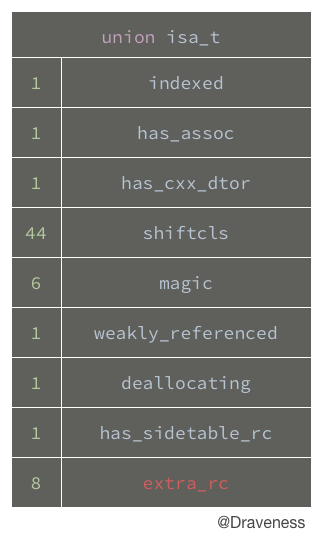关注仓库,及时获得更新:iOS-Source-Code-Analyze
由于 Objective-C 中的内存管理是一个比较大的话题,所以会分为两篇文章来对内存管理中的一些机制进行剖析,一部分分析自动释放池以及 autorelease 方法,另一部分分析 retain、release 方法的实现以及自动引用计数。
写在前面
在接口设计时,我们经常要考虑某些意义上的平衡。在内存管理中也是这样,Objective-C 同时为我们提供了增加引用计数的 retain 和减少引用计数的 release 方法。
这篇文章会在源代码层面介绍 Objective-C 中 retain 和 release 的实现,它们是如何达到平衡的。
从 retain 开始
如今我们已经进入了全面使用 ARC 的时代,几年前还经常使用的 retain 和 release 方法已经很难出现于我们的视野中了,绝大多数内存管理的实现细节都由编译器代劳。
在这里,我们还要从 retain 方法开始,对内存管理的实现细节一探究竟。
下面是 retain 方法的调用栈:
Objective-C
- [NSObject retain]└── id objc_object::rootRetain() └── id objc_object::rootRetain(bool tryRetain, bool handleOverflow) ├── uintptr_t LoadExclusive(uintptr_t *src) ├── uintptr_t addc(uintptr_t lhs, uintptr_t rhs, uintptr_t carryin, uintptr_t *carryout) ├── uintptr_t bits │ └── uintptr_t has_sidetable_rc ├── bool StoreExclusive(uintptr_t *dst, uintptr_t oldvalue, uintptr_t value) └── bool objc_object::sidetable_addExtraRC_nolock(size_t delta_rc) └── uintptr_t addc(uintptr_t lhs, uintptr_t rhs, uintptr_t carryin, uintptr_t *carryout)
复制代码
调用栈中的前两个方法的实现直接调用了下一个方法:
Objective-C
- (id)retain { return ((id)self)->rootRetain();}
id objc_object::rootRetain() { return rootRetain(false, false);}
复制代码
而 id objc_object::rootRetain(bool tryRetain, bool handleOverflow) 方法是调用栈中最重要的方法,其原理就是将 isa 结构体中的 extra_rc 的值加一。
extra_rc 就是用于保存自动引用计数的标志位,下面就是 isa 结构体中的结构:
接下来我们会分三种情况对 rootRetain 进行分析。
正常的 rootRetain
这是简化后的 rootRetain 方法的实现,其中只有处理一般情况的代码:
Objective-C
id objc_object::rootRetain(bool tryRetain, bool handleOverflow) { isa_t oldisa; isa_t newisa;
do { oldisa = LoadExclusive(&isa.bits); newisa = oldisa;
uintptr_t carry; newisa.bits = addc(newisa.bits, RC_ONE, 0, &carry); } while (!StoreExclusive(&isa.bits, oldisa.bits, newisa.bits));
return (id)this;}
复制代码
在这里我们假设的条件是 isa 中的 extra_rc 的位数足以存储 retainCount。
使用 LoadExclusive 加载 isa 的值
调用 addc(newisa.bits, RC_ONE, 0, &carry) 方法将 isa 的值加一
调用 StoreExclusive(&isa.bits, oldisa.bits, newisa.bits) 更新 isa 的值
返回当前对象
有进位版本的 rootRetain
在这里调用 addc 方法为 extra_rc 加一时,8 位的 extra_rc 可能不足以保存引用计数。
Objective-C
id objc_object::rootRetain(bool tryRetain, bool handleOverflow) { transcribeToSideTable = false; isa_t oldisa = LoadExclusive(&isa.bits); isa_t newisa = oldisa;
uintptr_t carry; newisa.bits = addc(newisa.bits, RC_ONE, 0, &carry);
if (carry && !handleOverflow) return rootRetain_overflow(tryRetain);}
复制代码
extra_rc 不足以保存引用计数,并且 handleOverflow = false。
当方法传入的 handleOverflow = false 时(这也是通常情况),我们会调用 rootRetain_overflow 方法:
Objective-C
id objc_object::rootRetain_overflow(bool tryRetain) { return rootRetain(tryRetain, true);}
复制代码
这个方法其实就是重新执行 rootRetain 方法,并传入 handleOverflow = true。
有进位版本的 rootRetain(处理溢出)
当传入的 handleOverflow = true 时,我们就会在 rootRetain 方法中处理引用计数的溢出。
Objective-C
id objc_object::rootRetain(bool tryRetain, bool handleOverflow) { bool sideTableLocked = false;
isa_t oldisa; isa_t newisa;
do { oldisa = LoadExclusive(&isa.bits); newisa = oldisa; uintptr_t carry; newisa.bits = addc(newisa.bits, RC_ONE, 0, &carry);
if (carry) { newisa.extra_rc = RC_HALF; newisa.has_sidetable_rc = true; } } while (!StoreExclusive(&isa.bits, oldisa.bits, newisa.bits));
sidetable_addExtraRC_nolock(RC_HALF);
return (id)this;}
复制代码
当调用这个方法,并且 handleOverflow = true 时,我们就可以确定 carry 一定是存在的了,
因为 extra_rc 已经溢出了,所以要更新它的值为 RC_HALF:
C
#define RC_HALF (1ULL<<7)
复制代码
extra_rc 总共为 8 位,RC_HALF = 0b10000000。
然后设置 has_sidetable_rc 为真,存储新的 isa 的值之后,调用 sidetable_addExtraRC_nolock 方法。
Objective-C
bool objc_object::sidetable_addExtraRC_nolock(size_t delta_rc) { SideTable& table = SideTables()[this];
size_t& refcntStorage = table.refcnts[this]; size_t oldRefcnt = refcntStorage;
if (oldRefcnt & SIDE_TABLE_RC_PINNED) return true;
uintptr_t carry; size_t newRefcnt = addc(oldRefcnt, delta_rc << SIDE_TABLE_RC_SHIFT, 0, &carry); if (carry) { refcntStorage = SIDE_TABLE_RC_PINNED | (oldRefcnt & SIDE_TABLE_FLAG_MASK); return true; } else { refcntStorage = newRefcnt; return false; }}
复制代码
这里我们将溢出的一位 RC_HALF 添加到 oldRefcnt 中,其中的各种 SIDE_TABLE 宏定义如下:
Objective-C
#define SIDE_TABLE_WEAKLY_REFERENCED (1UL<<0)#define SIDE_TABLE_DEALLOCATING (1UL<<1)#define SIDE_TABLE_RC_ONE (1UL<<2)#define SIDE_TABLE_RC_PINNED (1UL<<(WORD_BITS-1))
#define SIDE_TABLE_RC_SHIFT 2#define SIDE_TABLE_FLAG_MASK (SIDE_TABLE_RC_ONE-1)
复制代码
因为 refcnts 中的 64 为的最低两位是有意义的标志位,所以在使用 addc 时要将 delta_rc 左移两位,获得一个新的引用计数 newRefcnt。
如果这时出现了溢出,那么就会撤销这次的行为。否则,会将新的引用计数存储到 refcntStorage 指针中。
也就是说,在 iOS 的内存管理中,我们使用了 isa 结构体中的 extra_rc 和 SideTable 来存储某个对象的自动引用计数。
更重要的是,如果自动引用计数为 1,extra_rc 实际上为 0,因为它保存的是额外的引用计数,我们通过这个行为能够减少很多不必要的函数调用。
到目前为止,我们已经从头梳理了 retain 方法的调用栈及其实现。下面要介绍的是在内存管理中,我们是如何使用 release 方法平衡这个方法的。
以 release 结束
与 release 方法相似,我们看一下这个方法简化后的调用栈:
Objective-C
- [NSObject release]└── id objc_object::rootRelease() └── id objc_object::rootRetain(bool performDealloc, bool handleUnderflow)
复制代码
前面的两个方法的实现和 retain 中的相差无几,这里就直接跳过了。
同样,在分析 release 方法时,我们也根据上下文的不同,将 release 方法的实现拆分为三部分,说明它到底是如何调用的。
正常的 release
这一个版本的方法调用可以说是最简版本的方法调用了:
Objective-C
bool objc_object::rootRelease(bool performDealloc, bool handleUnderflow) { isa_t oldisa; isa_t newisa;
do { oldisa = LoadExclusive(&isa.bits); newisa = oldisa;
uintptr_t carry; newisa.bits = subc(newisa.bits, RC_ONE, 0, &carry); } while (!StoreReleaseExclusive(&isa.bits, oldisa.bits, newisa.bits));
return false;}
复制代码
使用 LoadExclusive 获取 isa 内容
将 isa 中的引用计数减一
调用 StoreReleaseExclusive 方法保存新的 isa
从 SideTable 借位
接下来,我们就要看两种相对比较复杂的情况了,首先是从 SideTable 借位的版本:
Objective-C
bool objc_object::rootRelease(bool performDealloc, bool handleUnderflow) { isa_t oldisa; isa_t newisa;
do { oldisa = LoadExclusive(&isa.bits); newisa = oldisa;
uintptr_t carry; newisa.bits = subc(newisa.bits, RC_ONE, 0, &carry); if (carry) goto underflow; } while (!StoreReleaseExclusive(&isa.bits, oldisa.bits, newisa.bits));
...
underflow: newisa = oldisa;
if (newisa.has_sidetable_rc) { if (!handleUnderflow) { return rootRelease_underflow(performDealloc); }
size_t borrowed = sidetable_subExtraRC_nolock(RC_HALF);
if (borrowed > 0) { newisa.extra_rc = borrowed - 1; bool stored = StoreExclusive(&isa.bits, oldisa.bits, newisa.bits);
return false; } }}
复制代码
这里省去了使用锁来防止竞争条件以及调用 StoreExclusive 失败后恢复现场的代码。
我们会默认这里存在 SideTable,也就是 has_sidetable_rc = true。
你可以看到,这里也有一个 handleUnderflow,与 retain 中的相同,如果发生了 underflow,会重新调用该 rootRelease 方法,并传入 handleUnderflow = true。
在调用 sidetable_subExtraRC_nolock 成功借位之后,我们会重新设置 newisa 的值 newisa.extra_rc = borrowed - 1 并更新 isa。
release 中调用 dealloc
如果在 SideTable 中也没有获取到借位的话,就说明没有任何的变量引用了当前对象(即 retainCount = 0),就需要向它发送 dealloc 消息了。
Objective-C
bool objc_object::rootRelease(bool performDealloc, bool handleUnderflow) { isa_t oldisa; isa_t newisa;
retry: do { oldisa = LoadExclusive(&isa.bits); newisa = oldisa;
uintptr_t carry; newisa.bits = subc(newisa.bits, RC_ONE, 0, &carry); if (carry) goto underflow; } while (!StoreReleaseExclusive(&isa.bits, oldisa.bits, newisa.bits));
...
underflow: newisa = oldisa;
if (newisa.deallocating) { return overrelease_error(); } newisa.deallocating = true; StoreExclusive(&isa.bits, oldisa.bits, newisa.bits);
if (performDealloc) { ((void(*)(objc_object *, SEL))objc_msgSend)(this, SEL_dealloc); } return true;}
复制代码
上述代码会直接调用 objc_msgSend 向当前对象发送 dealloc 消息。
不过为了确保消息只会发送一次,我们使用 deallocating 标记位。
获取自动引用计数
在文章的最结尾,笔者想要介绍一下 retainCount 的值是怎么计算的,我们直接来看 retainCount 方法的实现:
Objective-C
- (NSUInteger)retainCount { return ((id)self)->rootRetainCount();}
inline uintptr_t objc_object::rootRetainCount() { isa_t bits = LoadExclusive(&isa.bits); uintptr_t rc = 1 + bits.extra_rc; if (bits.has_sidetable_rc) { rc += sidetable_getExtraRC_nolock(); } return rc;}
复制代码
根据方法的实现,retainCount 有三部分组成:
这也就证明了我们之前得到的结论。
小结
我们在这篇文章中已经介绍了 retain 和 release 这一对用于内存管理的方法是如何实现的,这里总结一下文章一下比较重要的问题。
extra_rc 只会保存额外的自动引用计数,对象实际的引用计数会在这个基础上 +1
Objective-C 使用 isa 中的 extra_rc 和 SideTable 来存储对象的引用计数
在对象的引用计数归零时,会调用 dealloc 方法回收对象
有关于自动释放池实现的介绍,可以看自动释放池的前世今生。
关注仓库,及时获得更新:iOS-Source-Code-Analyze
本文转载自 Draveness 技术博客。
原文链接:https://draveness.me/rr










评论